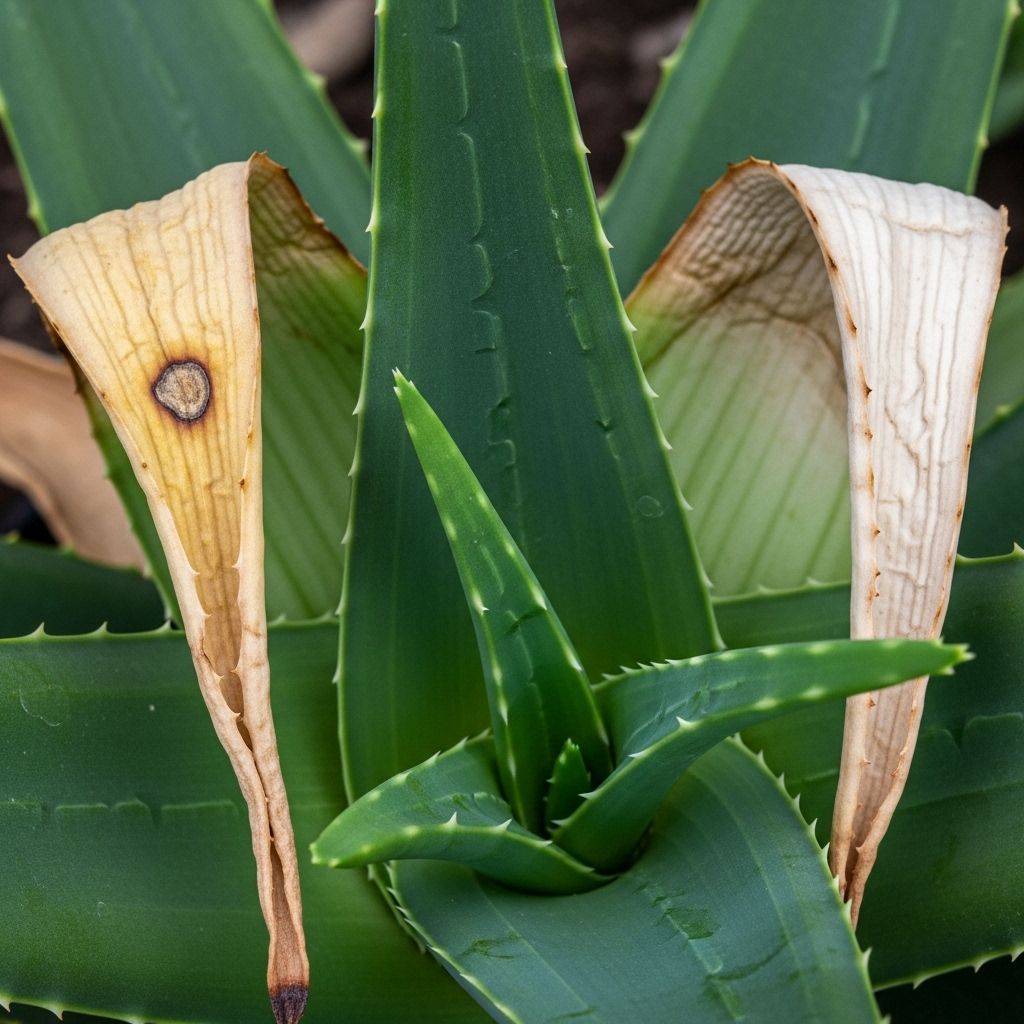Aloe Vera Plant Problems: 7 Expert Fixes For Healthy Growth
Discover the most common aloe vera plant problems, their causes, and step-by-step solutions to keep your aloe healthy indoors or outdoors.

Image: HearthJunction Design Team
Troubleshooting Common Aloe Vera Plant Problems
Aloe vera is a resilient, low-maintenance succulent prized for its healing sap and striking appearance, but even the hardiest plant can succumb to trouble. Yellowing leaves, mushy stems, brown spots, and floppy growth signal deeper issues in aloe care. Whether you keep your aloe outdoors in sun or nestled on a windowsill, this guide will help you diagnose, treat, and prevent the most frequent aloe vera plant problems.
Understanding Aloe Vera: Basic Care Essentials
Before jumping into problems, let’s clarify what aloe vera needs to thrive:
- Light: Bright, indirect light is ideal. Some direct sun is beneficial, but harsh, midday rays can scorch the leaves.
- Water: Allow soil to dry between waterings. Aloes store water in their leaves and dislike wet roots.
- Soil: Use a gritty, well-draining cactus or succulent mix to prevent waterlogging.
- Temperature: Warmth and good air circulation are best; keep out of frost and avoid chilly drafts.
- Pots: Terracotta pots with drainage holes are preferable over plastic or glass.
Common Aloe Vera Problems and How to Fix Them
Despite their durability, aloes can signal distress through their leaves, roots, or growth habit. Here are the most common problems and effective remedies:
Yellowing Leaves: Overwatering and Root Rot
If your aloe’s leaves are turning yellow, soft, or translucent, overwatering is likely. Aloe vera roots need to breathe; soggy or compacted soil suffocates them, leading to root rot.
- Symptoms: Yellow, mushy leaves; brown or black roots; foul odor from soil.
- Causes: Too frequent watering, poor drainage, incorrect soil.
- Solutions:
- Remove the plant from its pot and inspect the roots. Trim away any brown, mushy, or rotten sections with sterile scissors.
- Let roots air-dry for 1–2 days in a cool, dry place.
- Repot into fresh, well-draining soil in a clean container with drainage holes.
- Water sparingly and only when the top two inches of soil are dry.
Brown Leaf Tips and Sunburn
Brown, crispy edges or red-orange patches on aloe leaves often signal sunburn.
- Symptoms: Browning or reddening at leaf tips or sides; leaves may appear shriveled.
- Causes: Sudden exposure to intense sunlight, particularly behind glass or outdoors in summer.
- Solutions:
- Move the plant to a location with bright, indirect sunlight.
- If outdoors, gradually acclimate aloes to higher light rather than moving them abruptly from indoors to full sun.
- Prune badly scorched leaves to promote healthy new growth.
Drooping or Floppy Leaves
Aloe leaves should be plump and upright. If yours are limp and droopy, several care mistakes might be to blame.
- Symptoms: Leaves flop over the pot rim, appear limp or wrinkled.
- Causes: Overwatering, underwatering, low light, cold drafts, or being rootbound.
- Solutions:
- Review your watering routine and pot size. If soil is soggy, pause watering until dry; if bone-dry, give a thorough soak.
- Ensure the plant receives ample indirect sunlight and is not exposed to cold temperatures.
- Repot if roots fill the container or soil is exhausted.
Leaf Spot Disease: Fungal and Bacterial Issues
Leaf spots on aloe appear as brown, black, or reddish circular marks, often with a yellow halo. Fungal leaf spots (notably anthracnose) thrive in humid, damp conditions and poor air circulation.
- Symptoms: Small, water-soaked spots spread to become large, sunken, and dark lesions.
- Causes: High humidity, excess moisture on leaves, overcrowded growth.
- Solutions:
- Remove affected leaves to prevent disease spread.
- Improve air circulation around the plant and avoid overhead watering.
- Apply a safe fungicide—sulfur powder or neem oil is often effective against anthracnose and other fungal spots.
- Avoid copper fungicides unless absolutely necessary, as they can stain and persist in the soil.
Rootbound Aloe Plants
Aloes need space to grow. When roots circle tightly inside the pot, water cannot drain efficiently, leading to stress and stunted growth.
- Symptoms: Roots visible through the pot’s drainage holes or pushing up from the soil, plant tilting or refusing to grow.
- Solutions:
- Gently remove the plant, tease apart the rootball, and trim any excessively tangled roots.
- Repot into a slightly larger container with fresh, gritty soil.
Pest Problems: Mealybugs, Aphids, and Scales
Aloe vera is rarely a pest magnet, but mealybugs and aphids may occasionally invade. These pests suck sap, weakening the plant and sometimes transmitting disease.
- Symptoms: White, fluffy residue (mealybugs); sticky residue (honeydew); visible insects on leaves or roots; yellowing or deformed leaves.
- Solutions:
- Manually remove pests with a cotton swab dipped in rubbing alcohol.
- Rinse the plant gently under water to dislodge insects.
- For persistent infestations, use neem oil spray or insecticidal soap.
Soft Centers and Stem Rot
If the center of your aloe feels soft, dark, or hollow, stem rot may be present. This is a serious problem, usually caused by overwatering or a fungal infection at the base of the plant.
- Symptoms: Soft, mushy base or “heart” of the plant; foul odor; plant collapse.
- Solutions:
- Remove the plant from its pot and cut away all affected, mushy tissue.
- Allow healthy parts to air-dry, then replant in clean, dry cactus mix.
- If no healthy core remains, salvage uninfected leaf cuttings to propagate new plants.
Other Less Common Aloe Issues
- Edema: Occurs when roots absorb more water than the leaves can store, causing blisters on the leaf underside. Reduce watering frequency.
- Cold Damage: Chilling can create brown, sunken patches and leaf discoloration. Move plants inside during cold snaps.
- Fertilizer Burn: Overfertilizing leaves white crust on soil and brown leaf tips. Aloe needs very little fertilizer; feed sparingly.
Best Practices: Keeping Aloe Healthy and Problem-Free
- Keep your aloe in a location with bright, indirect sunlight; avoid harsh, direct sun or deep shade.
- Always allow soil to dry out before watering again.
- Use a sandy or gritty succulent potting mix and a pot with adequate drainage holes.
- Monitor for pests and treat at the first sign of infestation.
- Maintain low humidity and good air circulation indoors.
- Repot every 2–3 years to refresh soil and check for rootbound conditions.
Aloe Vera Problems and Solutions Table
| Problem | Symptoms | Likely Cause | Solution |
|---|---|---|---|
| Yellowing Leaves | Mushy, discolored leaves | Overwatering, root rot | Trim roots, repot in dry mix, water less often |
| Brown Leaf Tips | Crispy or red tips/edges | Sunburn, fertilizer burn | Move to indirect light, limit feeding |
| Drooping Leaves | Leaves flop or wilt | Over/underwatering, low light, rootbound | Adjust watering, check light, repot if needed |
| Leaf Spots | Dark, circular lesions | Fungal/bacterial disease | Remove affected leaves, use sulfur fungicide |
| Soft Center/Stem Rot | Squishy, dark base/leaves collapse | Fungal rot from excess moisture | Cut out rot, let dry, repot in fresh soil |
| Pests (Mealybugs, Aphids) | White fluff, sticky residue, deformed growth | Pest infestation | Remove with alcohol, use neem oil |
Frequently Asked Questions (FAQs)
Why are my aloe vera leaves turning brown?
Browning can result from sunburn, fertilizer burn, or even cold damage. Check for crispy tips (sunburn), white crusts on soil (overfertilization), or exposure to drafts. Adjust care accordingly.
How often should I water my aloe vera?
Water only when the top 1-2 inches of soil are completely dry. This can range from every 2–3 weeks in winter to every 7–10 days in summer, depending on temperature and humidity.
What’s the best soil mix for aloe vera?
Use a free-draining cactus or succulent mix. You can also make your own by combining two parts potting soil with one part sand or perlite.
Can aloe vera survive indoors?
Absolutely. Place your aloe near a bright window with indirect sun. Rotate regularly to ensure even growth and watch for signs of stretching or fading leaves.
How do I save a rotting aloe vera?
Remove all affected parts, let the healthy sections air-dry, and replant in fresh, dry soil. Only water once signs of new growth appear.
Is it safe to use aloe gel from a problem plant?
If your aloe is only experiencing cosmetic issues like minor sunburn, the gel is likely fine for use. However, avoid using gel from a plant suffering from rot or disease.
Conclusion
Aloe vera is famously forgiving but not invincible. By observing your plant’s appearance and understanding the signals it sends, you can correct most issues before they become fatal. Remember: resist the urge to overwater, use fast-draining soil, monitor for pests, and provide steady, bright light to keep your aloe thriving for years to come.
References
Read full bio of Anjali Sayee












